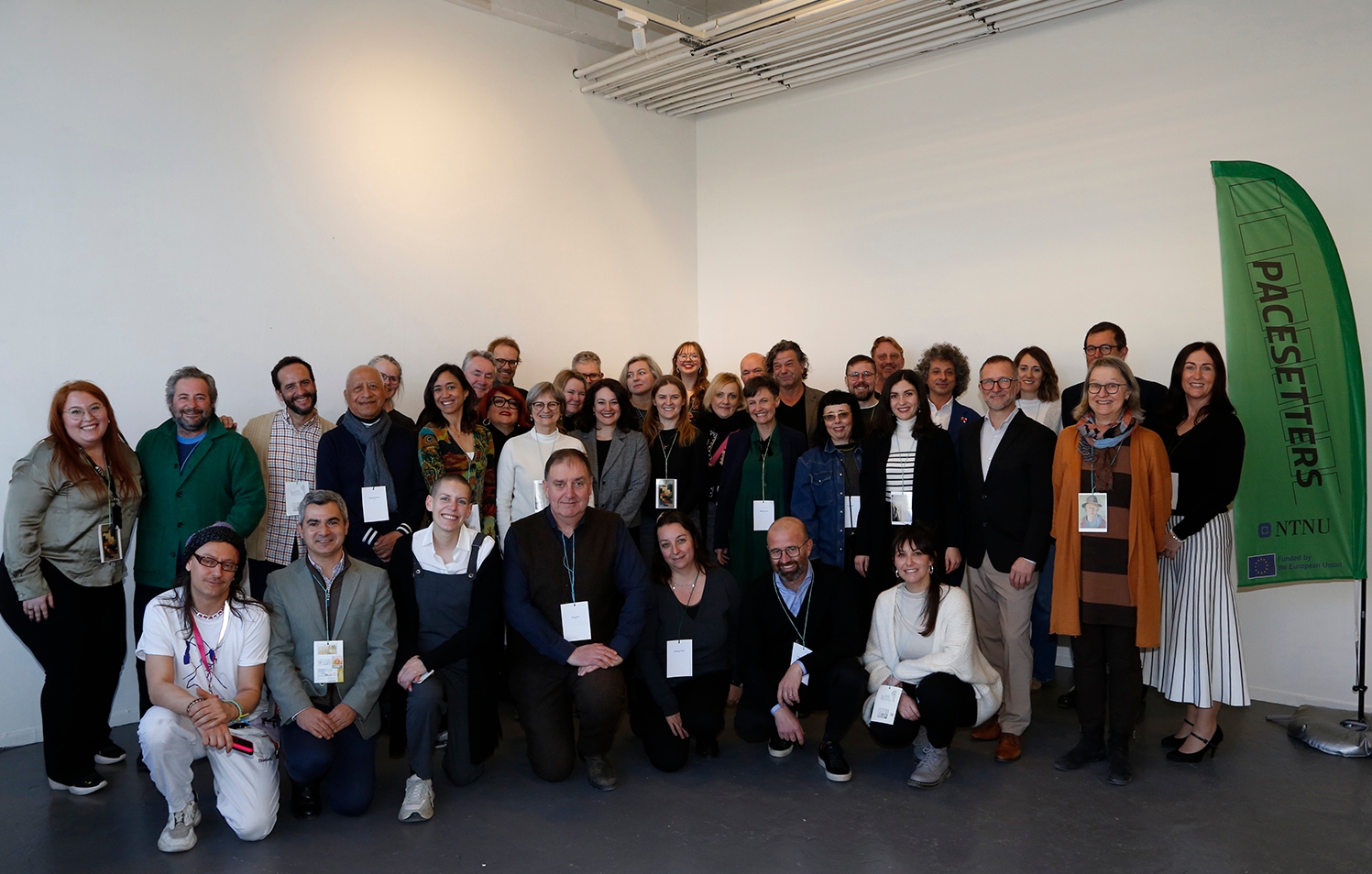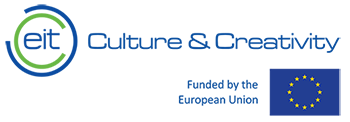Protection of Cultural Property at National and International Level
Art and Culture are advancing the climate transition
EU project / Duration: March 2024 - March 2027
"PACESETTERS" conducts collaborative, artistic and practice-based research to keep pace with transition. It tests innovative ideas to set the pace of transition and evaluates strategies to accelerate the pace of transition.
"PACESETTERS" is a powerful alliance of 15 partners of varying reach, size and focus. The consortium builds on extensive experience, outstanding competencies and specific expertise. It is fresh, dynamic and bold in its ambitions, yet experienced and solid enough to ensure it achieves its goals. With its diverse composition and high standards, it represents a new drive to push beyond the boundaries of business as usual and discover new, alternative and open end-ended solutions.
Much is at stake: unprecedented challenges demand everything to prevent the worst. However, crisis situations are full of potential for rethinking, undoing and reshaping.
EIT Culture & Creativity - A pioneering Partnership for a successful Europe
EU project / Duration: 2021 to 2027
The Innovation by Creative Economy (ICE) consortium, coordinated by the Fraunhofer-Gesellschaft, has been selected by the Governing Board of the European Institute of Innovation and Technology (EIT) as a new Knowledge and Innovation Community (KIC) in the cultural and creative sector. The European Partnership for Culture and Creativity aims to support students and start-ups to develop innovative products and processes in the creative industries and for the cultural heritage sector.
For the first time, an EIT partnership (KIC) will be coordinated by the Fraunhofer-Gesellschaft.
This partnership successfully competed against four other applicants in the selection process on 22 June in Budapest, Hungary. The goal is to capture the worth of the cultural and creative sectors and industries and the creative industries as enablers of Europe's green, digital and social transformation.
The EIT Culture & Creativity is coordinated by Dr. Johanna Leissner of the Fraunhofer Institute for Silicate Research ISC in Würzburg and led by Bernd Fesel as interim CEO. A budget of €6 million has been allocated for the start-up phase to ensure that this European partnership is fully operational as soon as possible. Once the partnership is fully operational, the annual grant will be increased and could reach around €70 million per year under the current Horizon Europe programme. In addition, the KIC is expected to leverage further funding from the private and public sectors.
"Fraunhofer, as coordinator of this EIT Culture & Creativity, wants to set new standards in the cultural and creative industries with its technologies and build on the success story of the MP3, thus making an important contribution to the EIT partnership. The MP3 algorithm developed by Fraunhofer is one of the most revolutionary products in the creative industries of the last 30 years" says Dr. Johanna Leissner. As chair of the EU OMC Expert Group on Cultural Heritage and Climate Change, she wants to bring more attention to the topic of cultural heritage research. With her expertise and many years of experience, she sees great potential and synergies. "EIT Culture & Creativity is a great opportunity for the cultural heritage sector to further advance research to adapt cultural heritage to climate change and for this issue to be heard by policy makers ".
Supported by:
Contact
Dr. Johanna Leissner
Fraunhofer Office Brussels
Rue Royale 94
B-1000 Bruxelles
Telefon +32 2 506 42 43
E-Mail-Contact
Sabrina Rota
Head of the International Centre for Cultural Heritage Protection and Conservation Research IZKK
Fraunhofer Institute for Silicate Research ISC
Bronnbach 28
97877 Wertheim
Telefon +49 9342 9221-701
E-Mail-Contact
Evaluation of the Model Application of ORMOCER®-Glass
DBU project / Duration: October 2020 - June 2023
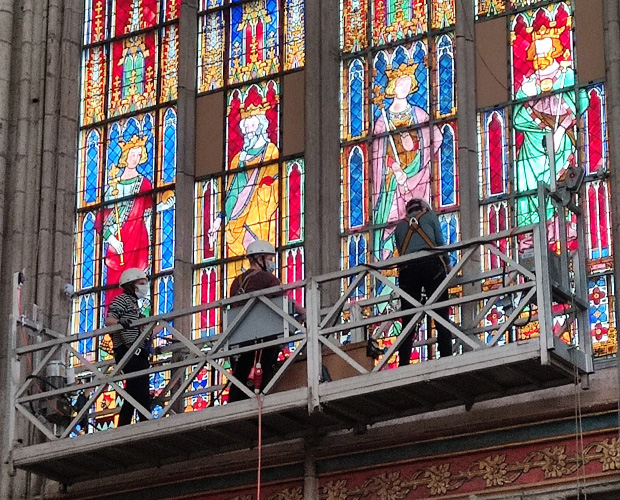
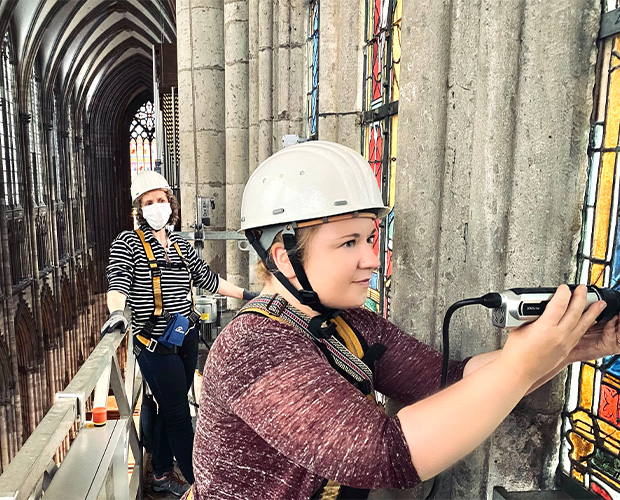
Coatings designed to protect valuable historical stained glass from environmental conditions and anthropogenic emissions.
ORMOCER® Glass was developed over 30 years ago as a tailor-made preservative. It was originally used as a protective layer against corrosion for vulnerable medieval glass surfaces - known as a composite coating. At Erfurt Cathedral, a modified technique was used to preserve damaged stained glass on modern antique glass. The first examples of this protective coating were applied between 1987 and 1990, and since then ORMOCER®-Glass has been used mainly in pioneering research projects. Although the practical conservation of historical monuments is fundamentally open to new methods and materials, their practical application is hesitant without long-term experience. With climate change expected to lead to increased corrosion, durable and sustainable preservatives are essential.
Meanwhile, the applications of ORMOCER®-Glass on the Herrgottskirche in Creglingen, the Erfurt Cathedral and the Cologne Cathedral have been re-evaluated after a further decade and a total of 30 years of weathering to verify the earlier positive assessments. The planned phases of the project were completed on schedule, despite delays caused by the ongoing coronavirus pandemic. Analysis of the very thin coating samples, measuring only a few micrometres, was particularly challenging, but provided valuable insights into the process for future analysis of the smallest samples.
The positive long-term results of ORMOCER®-Glass after more than three decades of use provide some reassurance for objects already treated with it and encouragement for more carefree use in the future. Although its importance as a corrosion protection coating has diminished, the material remains relevant for other conservation purposes, such as protecting damaged paint layers on stained glass windows. One advantage here is external protective glazing, ideally with UV protection, to preserve both the art object and the coating itself for longer. ORMOCER®-Glass has also been used to stabilise the surface of cracked glass in lead glazing, to strengthen glazed bricks and as a substitute for glaze in exterior applications.
Viktoriabad Bonn
Feasibility study / Duration: mid 2022 - mid 2023
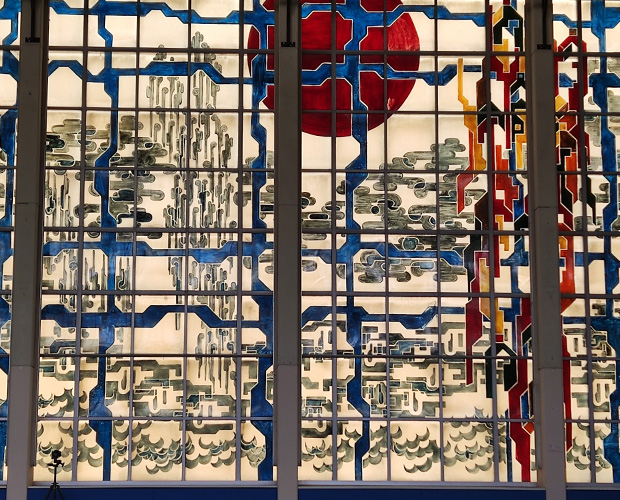
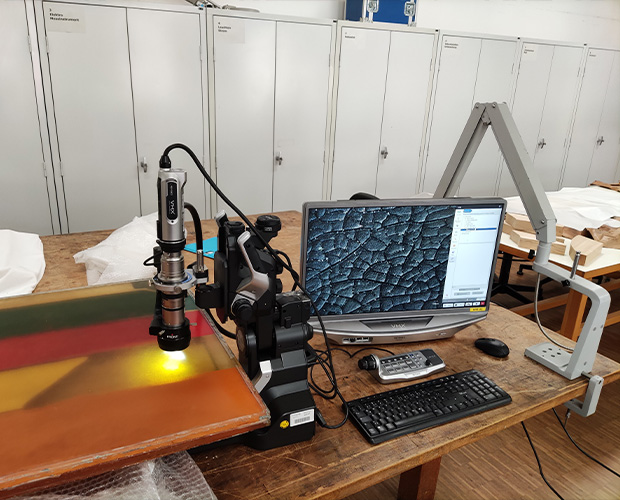
A feasibility study was carried out in collaboration with the LVR-Amt für Denkmalpflege im Rheinland (LVR-ADR) to test conservation methods for the damaged 30 m-long synthetic resin facade (glass-fibre reinforced polyester panels) of the former swimming pool. The facade is a listed building and was designed by Wilhelm Jungherz, who worked in the office of the renowned architect Gottfried Böhm. A particular challenge was the production of sample material.
The initial step involved identifying the precise polymer used in the original. Following that, the samples were cast. The critical step was to replicate the damage using different artificial weathering tests. The previously characterized damage profiles could not initially be replicated through accelerated aging. However, irradiation and manual damage produced samples with a damage structure comparable to the original. By optimising the pre-treatment and adjusting the formulation of the coating, a system with very good adhesion was found. However, after 6 weeks in the QUV test, some yellowing was observed. This aspect should be addressed in future studies e.g. by adding UV absorbers and stabilisers.
Nevertheless, this feasibility study provides a basis for further development of preservative materials for polymers.
Falke II
FHG project / Duration: End of 2020 - End of 2021
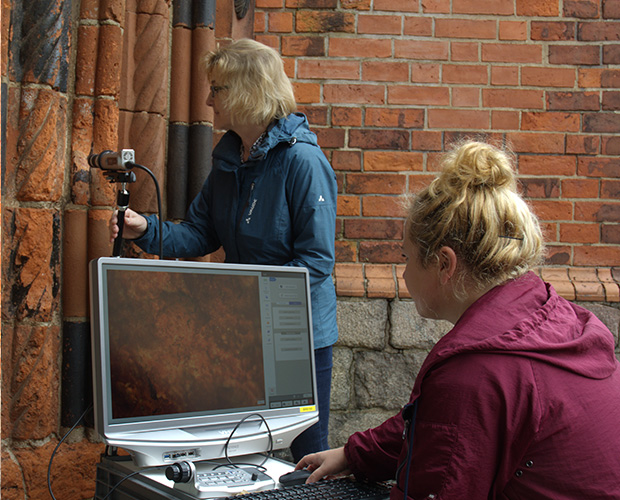
The longevity/resistance of the conservation material Glass-ORMOCER® (ORG) was analysed as part of a project by the Research Alliance for Cultural Heritage (FALKE) (funded by the Fraunhofer Society). Samples that had been exposed outdoors for several decades were analysed using vibrational spectroscopy. The data obtained showed no evidence of material degradation - the reversible conservation material developed at the Fraunhofer ISC remains intact even after decades of outdoor exposure.
Protection Concepts for damaged Enamel treasures
DBU Project / Duration: November 2015 - April 2019
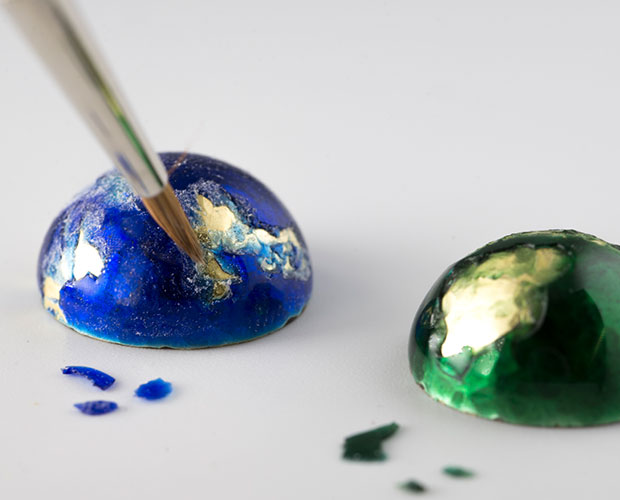

As part of a DBU project at the end of the 1990s, a specially adapted ORMOCER® resin was developed at the Fraunhofer ISC to preserve the corroded enamel coating of Johann Melchior Dinglinger's gold enamel treasures in the Green Vault in Dresden. In recent years, however, it was not possible to successfully synthesise the colourless ORMOCER® resin, mainly due to quality problems with the starting components. In addition, the synthesis of the resin was complex and based on chlorine-containing compounds, which needed to be simplified and converted to meet current requirements such as REACH compliance. The aim of this research project was to demonstrate the macroscopic stability of the hybrid material in the Green Vault after more than ten years of exposure also at the microscopic level through analytical tests on selected objects. By reproducing the synthesis according to the latest technical standards, the Glass-ORMOCER® material has now been reproduced and is available for use.
Nanomatch - Inorganic Nanomaterials for Heritage Conservation
EU Project / Duration: November 2011 - October 2014
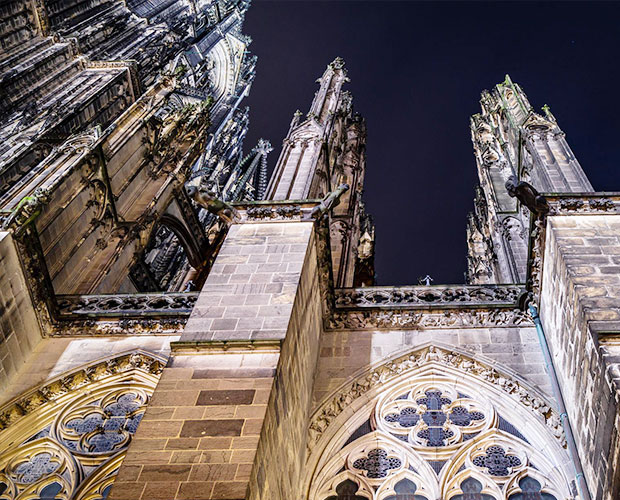
The problem of deterioration of historic building materials such as stone, wood and glass is becoming increasingly urgent. Climate change has increased natural deterioration, while socio-economic demands require a more sustainable use of the existing built heritage. The EU project NANOMATCH has addressed this problem and developed a family of innovative materials. These materials are specifically designed for the consolidation of historic substrates and the production of high performance products to fill the market gap in the conservation of built heritage. The Fraunhofer ISC had previously developed the conservation material A18 and used it to develop the highly moisture resistant material Cloisil A18.
Craquelée - Prevention of Cracks and Fissures in historic Glassware
DBU Project / Duration: November 2011 - October 2014

The partners, the Metropolitan Chapter of the High Cathedral Church of Cologne and the Fraunhofer Institute for Silicate Research (ISC), Würzburg, have studied the phenomenon of craquelure damage in 19th century glass. Amber glass is particularly affected. These show crack patterns ranging from superficial to deep cracks. This makes the glass unstable and changes the refraction of light. The exact causes of the damage are unclear, but polluted air could play a role. The cooperation partners have analysed the largely unexplored damage pattern and tested new methods for the consolidation and restoration of craquelure-damaged glass, both in the model and on originals.
Climate for Culture - Protecting Cultural Heritage
EU project / Duration: 2009 - 2014

Privacy warning
With the click on the play button an external video from www.youtube.com is loaded and started. Your data is possible transferred and stored to third party. Do not start the video if you disagree. Find more about the youtube privacy statement under the following link: https://policies.google.com/privacyClimate change not only threatens people and nature, but also our cultural heritage. Extreme heat and humidity will increasingly affect cultural artefacts in the future. In the EU research project "Climate for Culture", a multidisciplinary team of 27 partners, including the Fraunhofer ISC, investigated how to save historic buildings and their artefacts from decay. Climate models, measurement and forecasting methods were developed to assess the impact of climate change on the interiors of historic buildings and their art collections. The project also looked at what needs to be done in the future to ensure the sustainable air conditioning of historic buildings.
Memori - Effects of Pollutants in Museums
EU project / Duration: November 2010 - October 2013

As part of the 7th Research Framework Programme, the EU is funding an international research project on the detection, assessment and prevention of air pollutants. The main objective is to develop a dosimeter to assess air corrosivity. It is also investigating the effects of airborne compounds on art and cultural assets and developing strategies to prevent damage.
CONSTGLASS - Materials for the Conservation of Glass Windows
EU project / Duration: June 2007 - May 2010

CONSTGLASS, a pan-European research project, focused on the evaluation of conservation treatments carried out on outstanding stained glass windows in Europe over the last five decades. The windows analysed date from the Middle Ages and other periods. The epoxy restorations were carried out around 30 years ago and were a valuable indicator of the effects of permanent museum display in an artificially lit gallery on the long-term ageing of epoxy polymers. As part of the project, the Fraunhofer ISC developed the laboratory product 'A18', a conservation material for consolidating deep cracks in glass.
GLASSAC Conference − Glass Science in Art and Conservation
Conference / May 10-12, 2011

GLASSAC offers international glass experts a platform for exchange. The 3rd GLASSAC conference, held at Bronnbach Abbey, was dedicated to glass art from the 19th to the 21st century. Various aspects were covered, such as vessel glass, stained glass, glass mosaics and modern glass design in architecture. The topics of the conference included glass technology, analysis, conservation, dating and provenance.
